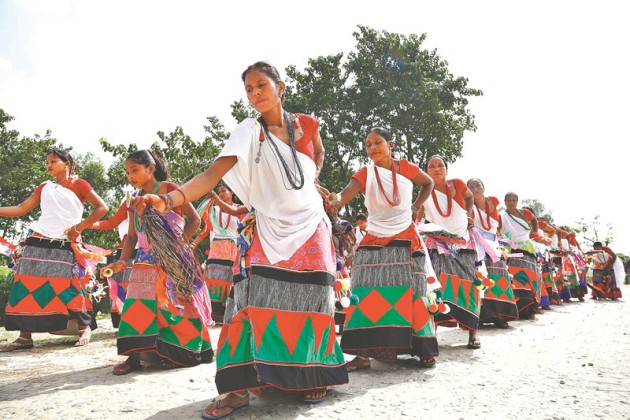Dance Sakhiya, Dance
 Prakash Chandra Timilsena: If you find yourself in the western region of Nepal around Dashain, there is one thing you don’t want to miss: the Sakhiya Naach.
Prakash Chandra Timilsena: If you find yourself in the western region of Nepal around Dashain, there is one thing you don’t want to miss: the Sakhiya Naach.
Practiced in districts such as Bardiya, Dang, Banke, Kailaili, and Kanchanpur; Sakhiya Naach is one of the most awaited and robustly celebrated rituals among Tharus—the indigenous people who pepper the far-western belt of the country. The Tharu community in Nepal boasts an extremely rich culture and an age-old affinity with the arts. Once the monsoon, the season for plantation, has subsided, the community indulges in merriment through traditional performances that fill the air with festive energy all year long.
As people of Bardiya soak in the festive aura of Dashain, Sakhiya Naach graces the community with melodies that impart wisdom inspired by the legendary tales of Lord Krishna. The songs to which Sakhiya is danced to also touch upon practical life lessons and guidelines for farming—the primary occupation in the region.
Sakhiya translates to ‘a friend’ and hence celebrates this very sense of belonging among the Tharus as they escape the humdrum of daily life. The dance is next to staple in the community’s religious, social and cultural way of life.
Sakhiya dance requires at least five male and 25 female performers. The men, garbed in vests and dhotis, play the Maadal. The women, who don white skirts, red blouses, and red ribbons on their head, dance to the drum’s beats while also playing oh, so colorful Mujuras in sync.
Women are the prime performers in this dance as they very gracefully steal the show with their inimitable dance moves and unparalleled charm.
From the beginning to the end, the Sakhiya Dance is ‘guarded’ with the ‘Tantrism’ of Guruwa, the chief priest of the village. The dance always starts at the Badghar’s—or the chieftain’s house—and eventually graces the local households. With Sakhiya, the performers lament for the beloved, departed souls of every household and get Dakshinas in return. The ritual then closes with a grand feast.
Originally, the Sakhiya Dance used to commence at least a month before Dashain and end only right after the festival. However, in the last few years the ritual has started only a few days ahead of the festival, ending on the day of the Tika. The duration has been shortened as a result of declining cultural interest and increasing alternative occupations found in the younger generation of the community.
Badghar Pradeshi Chaudhary, the chieftain of Khalla, Jaypur,, believes that it is important to salvage the essence of this one-of-its kind ritual and has been working on the same. These photographs were taken during Dashain at Rajapur municipality, ward no- 7, Khalla Jaypur of Bardiya District. Source: The Kathmandu Post
